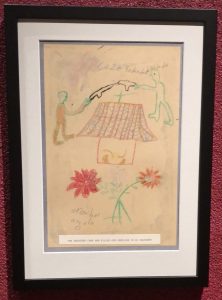There are some sleepless nights for anyone. Although the body is exhausted and craving for a nice peaceful sleep, somehow brain keeps working, playing back events from the day and keeps one awake until one is able to nail the messiness of the memory. It seems like muddy stream of memories and thoughts is flooding into the brain and being sluggish, being unable to process the memory. Well, I admit that a freshman at university, struggling to deal with so many things going on and being sleep deprived is a common experience and it is not a big deal. However, this drawing made me wonder what it is like for a child, to process the memory of her family killed.

The exhibit of “Arts of Resistance” was open from May 17th to September 30th in the Museum of Anthropology on the UBC Vancouver campus. As the homepage of the exhibit states, most of the objects express “contemporary political realities” by using “traditional or historical art forms” of Latin America. However, this picture drawn by Maribel Ayala in 1983 appeared slightly different from others to me. While the process of creating art works which include the intention of political resistance is somewhat retouching and editing the memory in order to express “neo-colonialism and racism”, a drawing of what a child saw seemed to be depicting the lurid reality and his or her own feeling straight forward.
Looking at the term, “editing”, this procedure can make the work concise and comprehensible, or can add and drop one’s purpose or bias. The movie we watched for our ASTU class, “Stories We Tell” by Sarah Polley, describes numerous perspectives to a story of a family by filming many people telling the “story” in front of the camera. In the movie, Michel Polley (Sarah’s foster father) points out that it is impossible for the movie to equally incorporate each perspective, since once she “edits” it, it will become Sarah’s perspective, which includes her thoughts or messages. Likewise, most of the artifacts at the exhibit can be said that it was edited in the meaning of adding Latin American people’s purpose, which facilitate them to convey the message of resistance. In contrast, the society’s purpose or others’ perspectives have not been added to Maribel’s drawing. It expresses only her subjective perspective, such as what she saw, felt, and remembered ― the story of her own memory. We can say that this drawing is edited by the exhibitor, added with a caption which includes the intention of letting know us the cruel story of genocide. However, the drawing itself shows how Maribel processed her memory of the murder of her family, regardless of the political issue.
Thinking about how Maribel didn’t include a political intention in the drawing as a being in a “group”, made me remind what we learned in our SOCI class, about how people connect oneself with the society. For instance, sociological imagination is the ability to consider the interconnections between the social history and individual biography. Being able to name a personal issue, such as “gender discrimination” or “racism”, sometimes becomes a source of liberation, by acknowledging the limitation of one’s control on one’s life. While the story is still catastrophic and painful, one can also gain solidarity with others who have the same experience. Yet, as I consider, as a child, Maribel must have not been able to understand what is happening for the whole society by using her sociological imagination. This must have made it harder to process the memory of her family killed for her than for an adult. Maribel must have suffered not only from the fact that her family was killed, but also from the isolated feeling of being unable to connect her incident to other’s experiences.
Including sociology or political issues, the world seemingly focuses primarily on the social issues, and this seems to be reasonable. However, what would happen for those who don’t know how to raise their voice to the world? What would happen for those who can’t use their sociological imagination to connect oneself to the society? Presumably, the big flow of memory will have to swirl forever.